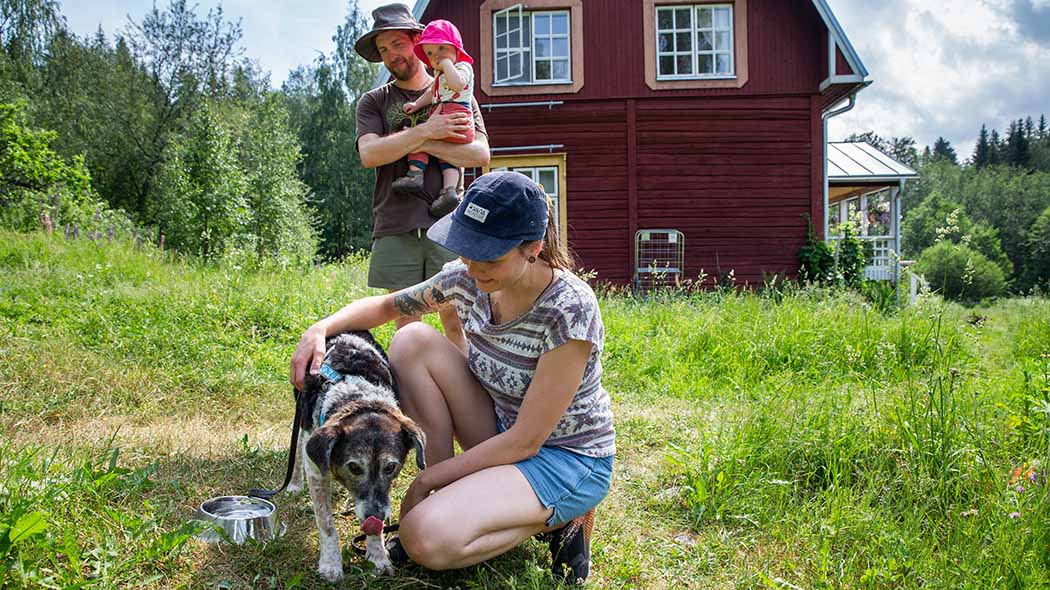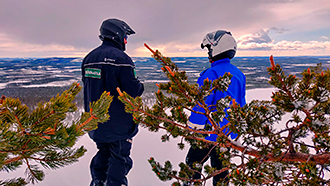Instructions and Rules in Koli National Park
Koli National Park was established to protect a representative area of North Karelian hills, old-growth forests with their plants and animals, and a central part of the national landscape in Koli. It is important to study matters dealing with the national park in advance and prepare yourself properly for your trip by reading the instructions, rules and regulations of the park (pdf 2,5 MB, julkaisut.metsa.fi, in Finnish).

Getting around in nature is limited in the restricted areas. Take a look at the restricted areas in the national park on Maps page and in Excursionmap.fi.
Respect Nature
Pets
Getting around in National Park
Camping
Lighting Campfires
Litter-free Hiking
Fishing
Picking Berries, Mushrooms and Wild Herbs
Biking
Other Rules and Instructions
Drone Flying
Forbidden Activities
Peak Seasons
Safety
Respect Nature
The outdoor activities in the Koli National Park are guided with the rules and regulations. When getting around in nature, let’s show respect for it. Take a look at the Outdoor Etiquette.
Please don’t share any such contents on the Internet that break the rules of the national park.
Letting pets running at large is forbidden. Dogs and other pets are welcome in the national park but only on a leash.
Getting around in National Park
In the Koli National Park, you may freely walk, ski, row and canoe, except in the restricted areas:
- Snowboarding and downhill skiing, which are forbidden on the natural slopes at the most important lookout points (Ukko-Koli, Akka-Koli and Paha-Koli). This is to conserve nature and to protect the safety of our guests.
- Landing on and access to restricted areas set up on small islands and islets to protect nesting birds are prohibited between 15 May and 15 July.
Camping
Camping is only permitted at designated sites.
Lighting Campfires
Lighting a fire is allowed at the maintained campfire sites that have been marked on the map and in the terrain. You are only allowed to use the firewood that has been reserved for the purpose. The person who lights a fire is always responsible for it and must also put it out.
The use of a portable camping stove is allowed in areas where hiking is allowed. During the wildfire warning, the use of hobo stoves is not allowed, as sparks may be created.
Lighting any campfires is strictly forhibited if the wildfire warning is in effect. Always check the current warnings (ilmatieteenlaitos.fi). This prohibition does not apply to cooking shelters or other fireplaces with a flue and a roof which in the area are Ryläys lean-to shelter and Rinnetupa Hut's lean-to shelters.
Litter-free Hiking
There are no waste-bins or recycling points in the park. Measures should be taken in advance to avoid taking unnecessary waste into the area. Take away everything you brought along.
In the Koli National Park, there are two types of toilets: dry toilets and suction toilets. In a dry toilet, you can recycle any biowaste produced along the way, but no waste other than human and wc-paper is to be put into a suction toilet. Any excess waste in the suction tank will cause problems and increase the cost of waste treatment.
Small amounts of clean paper and cardboard may be used as kindling at a campfire site or a fireplace at a hut. Other waste, such as packages that contain aluminium foil or plastic, may not be burned in a fireplace, as they may form non-biodegradable waste and toxic gases.
Read more about Hiking without littering.
Fishing
Hook and line fishing and ice fishing are allowed under everyman's rights, except where specific restrictions apply.
Persons aged 18-69 years must pay the fisheries management fee (eräluvat.fi). If you fish with more than one rod, you also need Metsähallitus' angling permit no 7413 for Southern Finland (eräluvat.fi). These permits can be purchased in the web shop (eräluvat.fi).
For trap fishing (in National Park water area off Koli), in addition to paying the fisheries management fee, you will need Metsähallitus' trap fishing permit no 7003 for Lieksa (eräluvat.fi). Permits can also be purchased by phone at +358 20 69 2424.
Fishers need to check the restrictions on fishing sites at kalastusrajoitus.fi (In Finnish).
Picking Berries, Mushrooms and Wild Herbs
Picking berries and edible mushrooms is allowed, except in restricted areas.
Taking or damaging trees, bushes, other plants or their parts, or mushrooms other than edible ones is forbidden. Picking wild herbs is therefore forbidden.
Biking
Cycling is only permitted on roads. Biking on the National Park's paths is prohibited to prevent wear and tear and for safety reasons.
Other Rules and Instructions
Parking is only allowed in designated car parking areas.
Hunting is only permitted for pest control purposes with Metsähallitus’ permission.
As a rule, a permit issued by Metsähallitus is required for activities other than those included in everyman's rights, which may include research, organised events and the shooting of films or advertisements in the terrain. Further information on required permits: research and access permits (metsa.fi) and permits and notifications related to events (metsa.fi).
The use of the trails and structures of the Koli National Park for business activities is always subject to a fee, and for frequent business use, a contract with Metsähallitus (metsa.fi) is required. The right of use fees for specific days are paid at the Eräluvat webshop (eraluvat.fi).
Drone Flying
Drone flying that disturbs other people and animals is prohibited in the Koli National Park. Flying drones above groups of people is prohibited for safety reasons. Especially during the summer, there are a lot of people in the area of Koli’s highest peaks. Read more about regional restrictions and regulations, which can be found at, for example, droneinfo.fi.
Forbidden Activities in the Koli National Park
- Damaging soil or rock, and extraction of earth material or minerals.
- Killing, catching or disturbing wild vertebrates, or damaging their nests.
- Catching or collecting invertebrates.
- Driving motor vehicles, except on roads designated for motor vehicles.
- Leaving waste in the area, or damaging structures.
- Covering, changing, damaging, removing, violating or excavating in archaeological sites.
- Activities that disturb other people.
Rules and Regulations for Koli
The rules and regulations of Koli National Park (in Finnish, pdf, 2.5 mb, julkaisut.metsa.fi), ratified on 18 september 1996.
Peak Seasons
The summer peak season begins at Mid-Summer at the end of June and ends at the start of the school-year in mid-August. The Ruska season, when leaves change color is around 20.9 to 10.10. Ski season begins in mid-February and continues into April. School camps come to the area in May.
The most popular area in Koli and Koli National Park is Ukko-Koli, where you can find the most important viewing points as well as Koli Nature Centre Ukko, Break Sokos Hotel Koli and ski slopes.
Safety
It is important that you get as much information as possible about your hiking destination in advance and prepare for your trip thoroughly. Knowing your route and sticking to it and knowing what the weather and warnings in effect (ilmatieteenlaitos.fi) has in store, will help make your trip a success.
- For longer treks we recommend that you take a large bottle of water as lake and flowing water may be scare in dry seasons or it could get soiled by animals or bacteria. Water taken from lakes or rivers should be boiled before drinking it.
- Before starting on the Herajärven kierros Trail, it is recommended that visitors ensure that they can cross the Sikosalmi strait on a hand-pulled raft and the Herajoki River using a wading cable. Further information is available on the What’s Currently Happening pages of Koli National Park and in Koli Nature Centre Ukko.
- The seasons are in sharp contrast to on another. The summer is hot and begins most years already in May. Autumns can be crisp, when warm clothes and good shoes are essential or rainy, when rain gear is needed. Winter usually begins in November. It is very cold and there is much snow. The snow banks melt in April and trails are still wet in May.
- To get to some tourist sights in the National Park, you will need specialised equipment.
- When visiting caves for example, you will need torches and stable shoes.
- Long hiking trails: a large bottle of water and good shoes.
- Dress for hiking in colorful clothes and according to the weather. Toilet paper are good to have along.
- There can be large differences in altitude within the National Park. Cliffs and trails can be especially slippery after rain, when they are frozen and when the snows melt. To avoid slipping, special caution is required on the steep slopes.
- When in the middle of a thunder storm it is best to not climb to the tops of hill as there is a danger of getting hit by lighting in high open places.
- When a lot of snow has fallen, the trees at tops of the Ukko-Koli and Mäkrävaara hills may cause dangerous situations when their branches break under the strain of the snow.
- Make sure you pack a first-aid kit. If you face an emergency on your hike, e.g. get lost, get injured or observe wildfire, call 112 and report an emergency. More information on how to act in an emergency.
- Mobile telephones work quite well in Koli National Park, except in some areas in the park where cliffs or forest block signals. Download the 112 Finland application (112.fi) to your phone.
- Outdoor Guide
Check for Warnings
 When wildfire warnings (en.ilmatieteenlaitos.fi) are in effect, fire is only allowed at covered campfire sites that have a flue. A fire can be also lit in fireplaces at wilderness and other huts. Always use extreme caution when handling fire. The one who lights a fire is always responsible for its safe use. Please note, that making fire at these campfire sites can be banned locally.
When wildfire warnings (en.ilmatieteenlaitos.fi) are in effect, fire is only allowed at covered campfire sites that have a flue. A fire can be also lit in fireplaces at wilderness and other huts. Always use extreme caution when handling fire. The one who lights a fire is always responsible for its safe use. Please note, that making fire at these campfire sites can be banned locally.

112 Emergency Number
If you have an emergency during your trip, such as getting lost, injured or finding a wildfire, call 112. Read more detailed emergency instructions.

Download the 112 Finland application (112.fi) to your phone. When an emergency call is made through the 112 Finland application, the emergency centre attendant is automatically informed of the caller's location.
It is recommended to keep the mobile phone warm and to bring extra food and water with you. There are many excursion locations with no mobile coverage and some mobile phones does not work in sub-zero temperatures, that is why it is always a good idea to let someone know about your itinerary and timetable.
Outdoor Etiquette

1. Respect nature.
2. Mainly use marked trails.
3. Camp only where it is allowed.
4. Light your campfire only where it is allowed.
5. Do not litter.
Game and Fisheries Wardens supervising nature destinations

Wilderness supervision (eräluvat.fi) offers services and education for the benefit of Finnish nature. A Game and Fisheries Warden is responsible for supervising the legality and authorisation of operations and the use of nature in state-owned areas.
If you witness or suspect a violation, you can report your observations to the warden (eräluvat.fi). Although we would like for you to leave your contact details when filing a report, you may also file a report anonymously.

